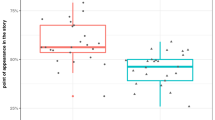Abstract
Subjects listened to a series of stories based on everyday activities, such as taking a shower, which in Schank's (1975a,b) terminology have familiar scripts. Script implications, like getting undressed, either were made explicit in the story or were left implicit. Unpredictable script variables, such as the temperature of the water, were specified. On an immediate sentence recognition test, subjects detected changes in the script variables more accurately than changes in the explicitness of the script implications. After a delay, test sentences with added or deleted script implications were falsely recognized and were judged to be as familiar as test sentences with no changes. The results supported the hypothesis that the memory representation for stories includes relevant script knowledge.
Similar content being viewed by others
References
Baggett, P. (1975). Memory for explicit and implicit information in picture stories.J. Verb. Learn. Verb. Behav. 14:538–548.
Barclay, J. R. (1973). The role of comprehension in remembering sentences.Cogn. Psychol. 4:229–254.
Bransford, J. D., and Johnson, M. K. (1973). Consideration of some problems of comprehension. In Chase, W. G. (ed.).Visual Information Processing, Academic Press, New York.
Bransford, J. D., Barclay, J. R., and Franks, J. J. (1972). Sentence memory: A constructive versus interpretive approach.Cogn. Psychol. 3:193–209.
Charniak, E. (1975) Organization and inference in a frame-like system of common sense knowledge. In proceedings ofTheoretical Issues in Natural Language Processing, Cambridge.
Fredericksen, C. H. (1975). Acquisition of semantic information from discourse: Effects of repeated exposures.J. Verb. Learn. Verb. Behav. 14:158–170.
Johnson, M. K., Bransford, J. D., and Solomon, S. K. (1973). Memory for tacit implications of sentences.J. Exp. Psychol. 98:203–205.
Kintsch, W. (1974).The Representation of Meaning in Memory, Erlbaum Associates, Hillsdale, N.J.
Paris, S. G., and Carter, A. Y. (1973). Semantic and constructive aspects of sentence memory in children.Dev. Psychol. 9:109–113.
Sachs, J. S. (1967). Recognition memory for syntactic and semantic aspects of connected discourse.Percept. Psychophys. 2:437–442.
Schank, R. C. (1975a). The structure of episodes in memory. In Bobrow, D. G., and Collins, A. M. (eds.),Representation and Understanding, Academic Press, New York.
Schank, R. C. (1975b). SAM—A story understander. Yale A. I. Project Research Report No. 43.
Schank, R. C., and Abelson, R. P. (1975). Scripts, plans, and knowledge. Paper presented at the 4th International Joint Conference on Artificial Intelligence, Tbilisi, USSR, August.
Schmidt, C. F. (1976). Understanding human action: Recognizing the plans and motives of other persons. In Carroll, J., and Payne, J. (eds.),Cognition and Social Behavior, Lawrence Erlbaum Press, Hillsdale, N.J.
Author information
Authors and Affiliations
Rights and permissions
About this article
Cite this article
Gibbs, R.W., Tenney, Y.J. The concept of scripts in understanding stories. J Psycholinguist Res 9, 275–284 (1980). https://doi.org/10.1007/BF01067242
Accepted:
Issue Date:
DOI: https://doi.org/10.1007/BF01067242




